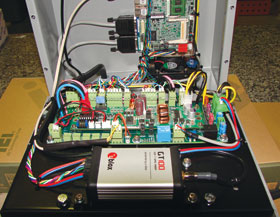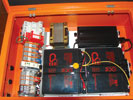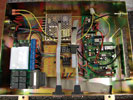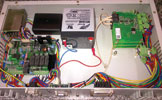

When thinking of panel assembly, many things might spring to mind.
Most households have a DB (distribution board), which is certainly a panel, but in more complex industrial applications a panel can mean much more: it can be a power supply used to power up complete systems; it can be a panel situated in the cabin of a train, from where many things are controlled; or perhaps a panel situated in a power station from which different systems are controlled or protected.

Whatever the application, a panel is needed to control, protect or distribute power in almost all industrial or commercial applications. A typical panel usually consists of an enclosure with a baseplate; trunking to channel wires; terminals and circuit breakers mounted on DIN rail or other brackets; customised modules or PCBs for specific tasks; perhaps a transformer or power supply and batteries; and of course cables with cable markers and ferrules, as well as labels.
The process of making these assemblies is quite involved, and requires a hands-on approach. The start of any such panel is typically the marking, drilling and tapping of holes to mount all the necessary items onto a baseplate. If the quantity and complexity justifies it, these baseplates might be custom made by getting them laser cut and bent, with all the necessary inserts and slots already installed, making the assembly somewhat easier.

There will usually be some cut-outs or holes to be drilled into the panel (enclosure) itself. While the mechanical work is in process, cable looms can be made up, and if there are PCBs to be assembled, this can also be done beforehand.
At the end of the day one would ideally want to have all the ‘loose components’ assembled before beginning with the final assembly, as this is when the panels start taking up lots of space, and become difficult to work with. Being able to do these subassemblies in-house definitely has its advantages, as all the processes can be controlled without having to subcontract certain parts.

After all the subassemblies have been completed, the assembly process moves up from the baseplate, installing all the necessary rails, trunking and brackets, and then all the required terminals, modules etc. Only after everything has been installed onto the baseplate will the wiring be done and, thereafter, testing.
Testing of the final product is of the utmost importance to make sure that all the processes can be controlled correctly, and to ensure that the wiring has been done correctly. After the testing process a few labels might get added and the panel is ready to be quality inspected and delivered to the client.
Doing just the panel assemblies does not necessarily require highly skilled personnel, but having people with good technical knowledge and practical experience is definitely an advantage, especially when all the different subassemblies are taken into account.
At DDZ Technologies we have been involved in many different types of panel assemblies in the course of the 10 years that we have been in the industry. They have come in many different sizes and complexity, from explosive-proof panels used in the mining sector to large distribution panels used on alternative energy plants to industrialised computers used in the railway and farming sectors, as well as panels for the telecoms industry.
Should the exact enclosure needed for a panel not be available off the shelf, we can have it designed and manufactured locally. Whether it be a stainless steel enclosure or a mild steel enclosure powder coated in any colour, we have the correct companies lined up to do exact plate steel manufacturing for all our panel needs.

© Technews Publishing (Pty) Ltd | All Rights Reserved